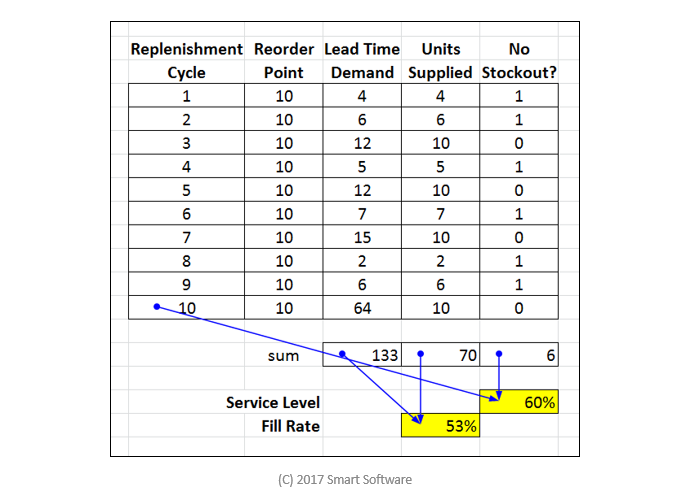We are often asked what the difference is between these two important performance metrics for inventory planning. While they are both important for measuring how successful a business is in meeting demand, their meaning is very different. If not understood and incorporated into the strategic inventory planning process, inventory will be inefficiently allocated resulting in lower customer service and higher carrying costs. We’ve illustrated the difference in this 4 minute recording using Microsoft Excel.
 Smart Operational Analytics automatically calculates historical service levels & fill rates across any item. To see how you calculate these and other operational metrics including inventory turns, supplier performance, and more register below to watch a five minute demonstration. The demo will show how our cloud platform continuously calculates and reports these metrics across thousands of items helping you identify opportunities for service level improvement and inventory reduction.
Smart Operational Analytics automatically calculates historical service levels & fill rates across any item. To see how you calculate these and other operational metrics including inventory turns, supplier performance, and more register below to watch a five minute demonstration. The demo will show how our cloud platform continuously calculates and reports these metrics across thousands of items helping you identify opportunities for service level improvement and inventory reduction.
Related Posts

Managing Spare Parts Inventory: Best Practices
In this blog, we’ll explore several effective strategies for managing spare parts inventory, emphasizing the importance of optimizing stock levels, maintaining service levels, and using smart tools to aid in decision-making. Managing spare parts inventory is a critical component for businesses that depend on equipment uptime and service reliability. Unlike regular inventory items, spare parts often have unpredictable demand patterns, making them more challenging to manage effectively. An efficient spare parts inventory management system helps prevent stockouts that can lead to operational downtime and costly delays while also avoiding overstocking that unnecessarily ties up capital and increases holding costs.

12 Causes of Overstocking and Practical Solutions
Managing inventory effectively is critical for maintaining a healthy balance sheet and ensuring that resources are optimally allocated. Here is an in-depth exploration of the main causes of overstocking, their implications, and possible solutions.

FAQ: Mastering Smart IP&O for Better Inventory Management.
Effective supply chain and inventory management are essential for achieving operational efficiency and customer satisfaction. This blog provides clear and concise answers to some basic and other common questions from our Smart IP&O customers, offering practical insights to overcome typical challenges and enhance your inventory management practices. Focusing on these key areas, we help you transform complex inventory issues into strategic, manageable actions that reduce costs and improve overall performance with Smart IP&O.










